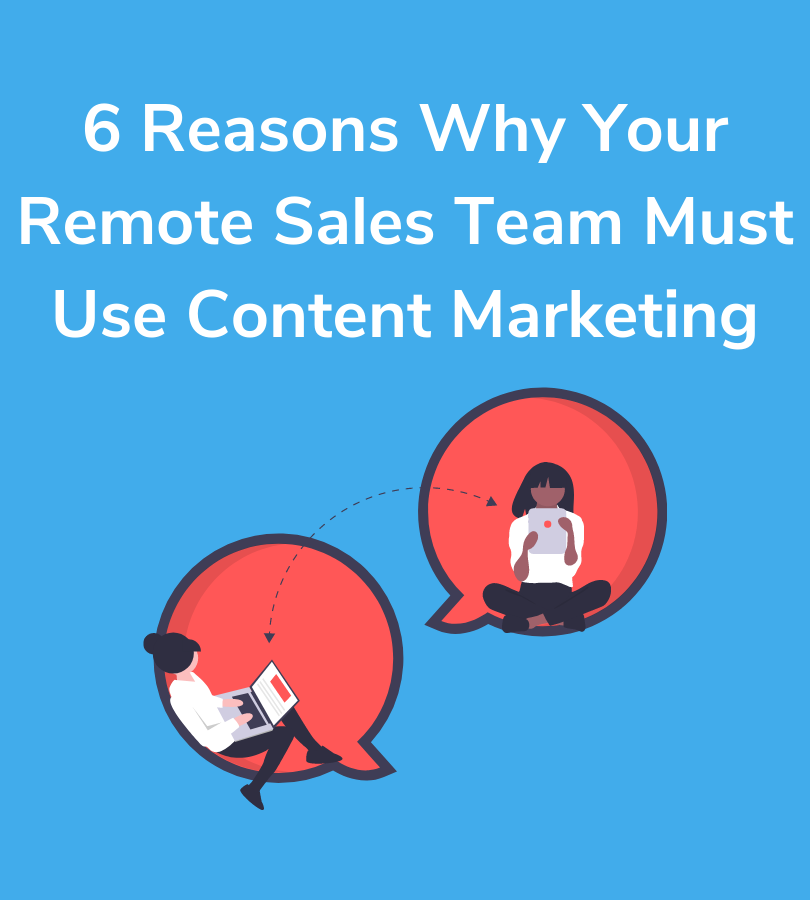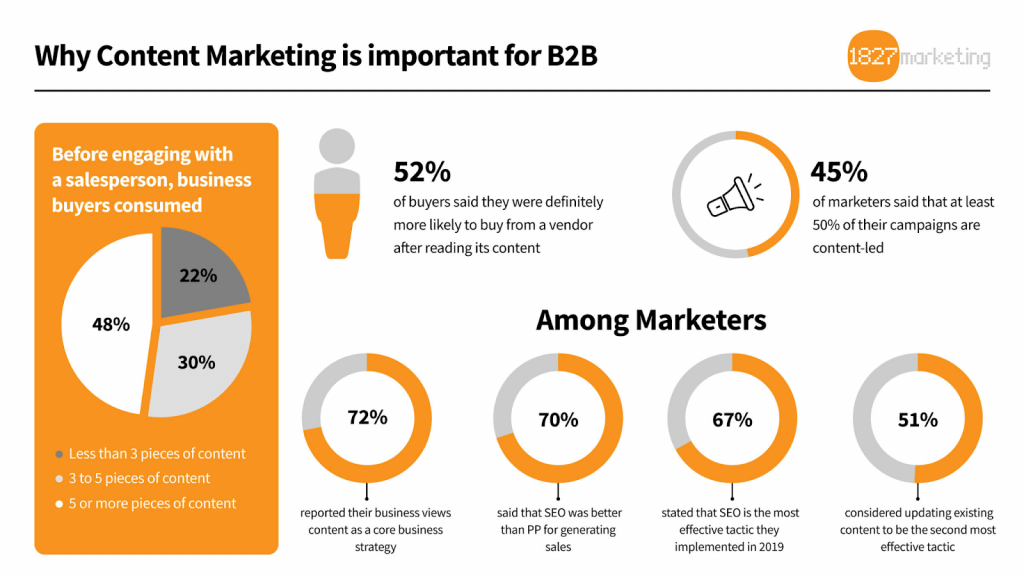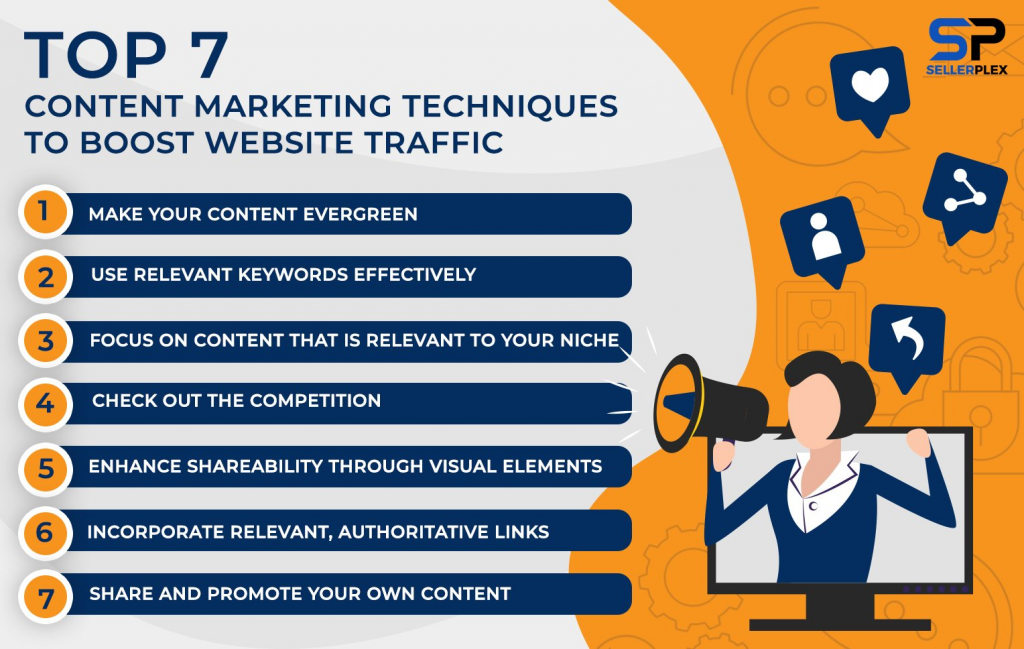Salespeople have had to adapt fast to the remote world, learning new techniques and systems of working to help them hit and exceed their targets while away from the office.
In doing so, they have had to overcome several unique challenges. They have found ways to shut out distractions, deal with the lack of meaningful communication, and cope without in-person support from sales leaders and colleagues.
So it stands to reason that they need all the help they can get to hit their targets.
Fortunately, your marketing team can lighten some of the load by creating high-quality content that your prospects want to engage with. Here are six ways content marketing can benefit your remote sales team.
1. B2B Buyers Love Thought Leadership Content
Thought leadership content – that is, content based on information, opinions, and experiences that are unique to your organization – is a huge win for sales teams.
Why? Because decision-makers love it.
According to LinkedIn, most decision-makers spend at least one hour a week consuming thought leadership, so it’s hardly surprising that 53% of marketers are diverting a greater proportion of their resources toward creating this type of content.
The effectiveness of thought leadership stems from its ability to position your organization as an authority in its field. When your company’s name gets referenced in relation to solving specific problems and achieving specific results, you become more credible. That makes your sales team’s job a whole lot easier, creating a natural “in” with prospects who already know who you are and understand the value you add.
Want to know the best thing about thought leadership? The more of it you create and share, the more problems you solve for prospective clients, and the more authoritative you become.
(source)
2. Content Supports Sales Enablement Strategies
Sales enablement strategies are all about implementing processes and systems that help your sales and marketing teams have more valuable, meaningful conversations with current and future customers.
Content marketing is one of the most impactful sales enablement tools in a remote sales team’s toolkit.
The phrase “sales enablement content” effectively refers to any type of content asset that your reps can use to engage prospects during the buying process.
Sharing the right piece of content at the right time can address prospects’ concerns, answer their questions, and demonstrate that your product or service provides the best solution to the problems they’re facing.
From a sales enablement perspective, your biggest challenge is to build a culture of collaboration between your sales and marketing functions. That way, these teams can work together to define the pain points facing prospects at each point in the sales funnel, allowing marketing to create the most impactful content.
3. Content Marketing Drives Organic Traffic & Leads
Of course, content doesn’t just play a valuable role in outbound marketing strategies. It also brings in organic traffic, which can turn your website into a platform for generating leads, especially when your marketing efforts are coupled with SEO.
Simply put, organizations that excel at content marketing attract more visitors to their sites. According to Aberdeen Strategy & Research, leaders in content marketing see almost eight times more year-on-year growth in unique traffic than content marketing followers.
However, this isn’t just about making the graphs on your analytics dashboards look more impressive. Traffic isn’t a goal in itself, but it does help you drive sales leads through onsite elements like contact forms and chat bots.
When your sales plan aligns closely with your marketing function, those leads can be quickly passed to your sales development representatives (SDRs) for nurturing until they are ready to buy.
(source)
4. Content Helps Nurture Leads Through the Sales Funnel
So how, specifically, should your SDRs be nurturing leads?
They could spend huge amounts of time in one-on-one conversations, crafting tailored answers to specific questions. However, this resource-intensive approach can only be justified for the highest-value leads.
Or alternatively, they can share relevant content that speaks to common pain points encountered at various stages of the sales funnel. That way, they can nurture multiple leads through a single email campaign or social post.
Lead nurturing becomes a simple task when your company builds up a catalog of quality digital assets, from eBooks and infographics to explainer videos and case studies.
(source)
5. Sharing Content Makes Your Sales Team More Efficient
As discussed in the previous point, sharing content doesn’t just make for more effective lead nurturing – it makes your sales function a far more efficient operation.
Everyone knows salespeople are busy. Yet almost two-thirds of your reps’ time is spent on activities that don’t actually generate revenue, leaving just one-third for key tasks like prospecting and outreach.
With so much demand on their time, reps simply don’t have the bandwidth to maintain lengthy, in-depth conversations with every prospect.
That’s where content marketing comes in.
Much of what a sales rep needs to communicate to a prospect can be facilitated through effective content. For instance, rather than spelling out exactly how your product helps companies in specific industries, share a relevant case study or webinar. Or instead of explaining individual features and benefits, share a video explainer or product demo. Additionally, the sales reps can really use a good CRM solution for sales to better manage a long list of repetitive tasks. However, it’s always beneficial to do some homework on potential CRM software you might be using in your company before you invest your time and money in it.
That saves a lot of time that can instead be spent on generating leads and closing deals. With a CRM system that has features like sales tracking, deal flow management, and contact management for small business or any scale of business, sales teams can easily track every aspect of their sales process. From identifying potential leads to closing a deal, the software helps keep everything organized and on track.
6. Content Answers Common Buyer Questions
Unless you have an extremely low-cost product, your prospects will almost certainly want answers to a wide range of questions before they’re even prepared to attend a product demo, let alone sign off on the deal.
However, only a small proportion of those questions will be completely unique. Far more often, they will revolve around common pain points like:
- Price
- Length of contract
- Integrations
- Functionality
Tasking your reps with providing personalized responses to each and every one of those questions simply isn’t practical. It’s far too labor-intensive and would take too long, resulting in a poor experience for your leads. If they can’t get the answers they need from you, rest assured they will look elsewhere.
This is why it makes sense to create content that speaks to these common questions.
Beyond the issue of timing and efficiency, there are other benefits to answering buyer queries by sharing relevant content assets.
Firstly, the content you share can be easily circulated among decision-makers on the buyer’s side, in a way that a one-on-one conversation between a prospect and a rep simply can’t be.
For another, sharing content highlights the professionalism of your sales and marketing functions.
It also demonstrates that you have taken the time to anticipate and understand your prospects’ needs, which can go a long way toward reassuring potential customers about your experience and expertise.
Author Bio
Sujan Patel is a partner at Ramp Ventures & co-founder of Mailshake. He has over 15 years of marketing experience and has led the digital marketing strategy for companies like Salesforce, Mint, Intuit and many other Fortune 500 caliber companies.




